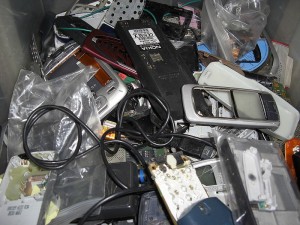 In 2010, the world met a significant, though largely unnoticed, milestone when the five billionth cell phone subscription was purchased. In the US alone, we now have 285 million cell phone users. While cell phones are manufactured to last for at least five years with proper care and maintenance, most users will replace their old cell phone with a newer model within less than two years. Rapidly advancing technology and the popularity of multifunctional smart phones drive the high turn-over rate. In the US today, there are over 700 million used cell phones awaiting disposal, reuse, or recycling, with more being made outdated, obsolete, and unwanted every day.
In 2010, the world met a significant, though largely unnoticed, milestone when the five billionth cell phone subscription was purchased. In the US alone, we now have 285 million cell phone users. While cell phones are manufactured to last for at least five years with proper care and maintenance, most users will replace their old cell phone with a newer model within less than two years. Rapidly advancing technology and the popularity of multifunctional smart phones drive the high turn-over rate. In the US today, there are over 700 million used cell phones awaiting disposal, reuse, or recycling, with more being made outdated, obsolete, and unwanted every day.
Cell phones, though, are just the tip of the iceberg. According to the EPA, Americans own 3 billion televisions, computers, monitors, MP3 players, and other electronic equipment. Each year, hundreds of millions of these electronics are removed from use, with an astounding two-thirds of those still in working condition.
While the average household spends over $1,000 annually on the purchase of the newest, sleekest, smartest electronics, thousands of tons of valuable or useful materials, including glass, plastics, and metals such as gold, are being wasted. About 44% of the electronic products that enter the municipal solid waste stream are disposed of, mostly in landfills. Because disposal of items like computers and televisions has been largely unregulated until recently—even today, most states don’t mandate electronics’ disposal (New York State is an exception) —many hazardous materials used in electronics, including heavy metals such as lead, mercury, and cadmium, have created serious environmental problems. It is estimated that about 40% of the lead in landfills and the majority of mercury in solid waste streams is from consumer electronics.
There is some good news. Over the past decade, the total volume of unwanted consumer electronics collected for recycling has grown. Unfortunately, the trend to recycle has not been able to keep pace with the increasing number of electronics entering the waste stream. The amount of post-consumer electronics destined to be recycled in the country has held steady at about 11%.
The remaining percentages of obsolete consumer electronics sit in storage, languishing in drawers, closets, and the corners of dusty basements. While “out of sight, out of mind” might work in the short term, it is not a very good solution to the problem of electronic waste. Luckily, if you are one of those people holding on to old and unwanted electronics, there are many local options for recycling or donating these items.
If your unwanted electronics are still in good, working order consider donating to a local non-profit. Many would be happy to give a new home to your old computer, monitor, printer, scanner, or other office equipment.
For electronics that no longer function or are otherwise not suitable for reuse, the best option is to drop the items off for recycling. Though such items are not currently regulated as hazardous waste, the recently passed New York State Electronics Equipment Recycling and Reuse Act will ban the disposal of electronics by individuals and households by 2015. City agencies, schools, business, and non-profits are already required to recycle their unwanted electronics. E-recycling events are held throughout the year in the city. Visit the NYCWasteLess EVENTS CALENDAR to find upcoming e-recycling events in your community.
Additionally, many major electronics retailers, including Best Buy, Staples, and Target, offer in-store recycling drop-off options for old cell phones, computers, monitors, televisions, and other entertainment equipment. The City of New York website maintains an informative list of retail electronics recycling drop-off or manufacturer mail-in options that you can find by clicking on this NYC.Gov link.
For cell phones, in particular, there are many excellent recycling/reuse resources. Before donating your old cell phone, be sure to terminate your service contract for the phone, clear any personal data from the phone, and remove the SIM card.
The Verizon Wireless Hopeline Program will refurbish donated cell phones to benefit local survivors of domestic violence;
The Wireless Foundation’s Call to Protect initiative provides domestic violence victims with refurbished cell phones preprogrammed with emergency numbers;
By dropping off your old cell phone, charger, and accessories at an AT&T Wireless store you can help support Cell Phones for Soldiers, a program that distributes phone cards to American troops overseas.
-Filomena Riganti


